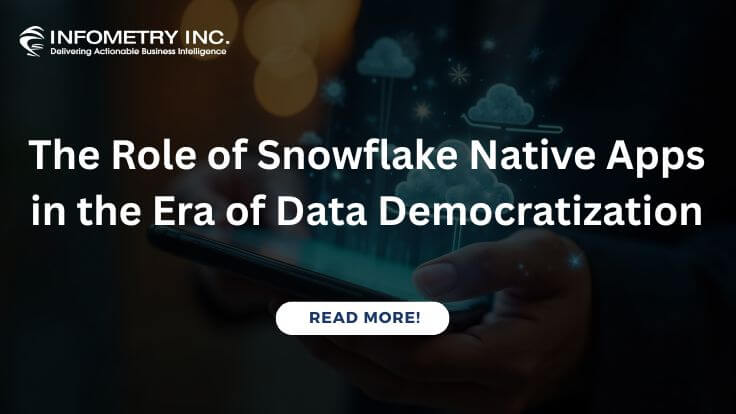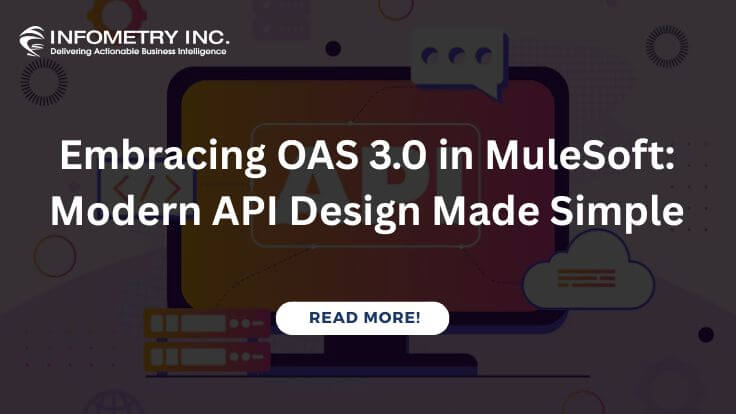
Data Analytics Trends 2024 & Beyond
April 15, 2024
Distinguishing Business Intelligence, Artificial Intelligence, and Advanced Analytics
April 18, 2024In the fast-paced world of data management, staying ahead of the curve is crucial for businesses striving to remain competitive. With the exponential growth of data, traditional data lakes are struggling to keep up with modern demands. Enter Snowflake – a cloud-based data platform revolutionising how organizations manage, store, and analyze their data. In this step-by-step guide, we’ll explore how Infometry, in collaboration with Snowflake, can help modernize your data lake, paving the way for enhanced efficiency, scalability, and performance.
Understanding the Need for Modernization
Traditional data lakes, while once hailed as the pinnacle of data storage and processing are now facing several challenges. These challenges include:
Scalability: Traditional data lakes often need help to scale efficiently to meet the growing demands of data ingestion and analysis.
Complexity: Managing and maintaining traditional data lakes can be complex and resource-intensive, requiring specialized skills and infrastructure.
Performance: As data volumes increase, traditional data lakes may experience performance bottlenecks, leading to slower query response times and decreased productivity.
Cost: On-premises data lakes can incur high upfront costs for infrastructure and ongoing maintenance, making them financially burdensome for many organizations.
Introducing Snowflake: The Modern Data Platform
Snowflake is a cloud-based data platform that offers a revolutionary approach to data management. Built for the cloud from the ground up, Snowflake eliminates the limitations of traditional data lakes by providing:
Scalability: Snowflake’s architecture allows for seamless scalability, enabling organizations to handle massive volumes of data with ease.
Simplicity: With its fully managed service model, Snowflake simplifies data management by handling infrastructure provisioning, maintenance, and optimization, freeing up resources for more strategic tasks.
Performance: Snowflake’s unique architecture decouples storage and computing, enabling organizations to independently scale resources based on their specific needs, resulting in lightning-fast query performance.
Cost-effectiveness: Snowflake offers a pay-as-you-go pricing model, eliminating the need for upfront infrastructure investments and providing cost predictability as data volumes grow.
Modernizing Your Data Lake with Snowflake: A Step-by-Step Guide
Step 1: Assessment and Planning
The first step in modernizing your data lake with Snowflake is to conduct a comprehensive assessment of your existing data infrastructure. This involves:
Identifying Pain Points: Assess the current state of your data lake, including scalability, performance, and cost considerations.
Defining Objectives: Clearly define your goals and objectives for modernization, such as improving query performance, reducing costs, or enhancing scalability.
Infrastructure Audit: Evaluate your existing infrastructure and identify any gaps or areas for improvement.
Step 2: Architecture Design
Once you have assessed your current state and defined your objectives, the next step is to design a modernized architecture with Snowflake. This involves:
Cloud Migration Strategy: Determine the most suitable cloud environment (AWS, Azure, or GCP) for hosting Snowflake based on your organization’s requirements and preferences.
Data Modeling: Design a scalable and efficient data model that aligns with Snowflake’s best practices and leverages its unique features, such as semi-structured data support and automatic scaling.
Integration Planning: Identify integration points with existing systems and applications, such as data sources, ETL pipelines, and BI tools, and develop a migration plan for seamless integration with Snowflake.
Step 3: Implementation and Migration
With the architecture design in place, it’s time to implement and migrate your data lake to Snowflake. This involves:
Data Ingestion: Migrate existing data from your data lake to Snowflake using various ingestion methods, such as bulk loading, streaming, or third-party tools.
ETL Pipeline Migration: Replicate and optimize existing ETL pipelines for Snowflake, leveraging its native integrations with popular ETL tools like Informatica and Talend.
Testing and Validation: Thoroughly test the migrated data and ETL processes to ensure data integrity, accuracy, and performance before transitioning to production.
Step 4: Optimization and Performance Tuning
Once your data lake has been modernized with Snowflake, the next step is to optimize and fine-tune its performance. This involves:
Query Optimization: Analyze query performance using Snowflake’s built-in monitoring and optimization tools, such as query profiling and execution statistics, and optimize queries for better performance.
Workload Management: Implement workload management policies to prioritize and allocate resources efficiently based on workload priorities and business requirements.
Cost Optimization: Monitor and optimize resource utilization to minimize costs, such as resizing warehouses based on workload patterns and leveraging Snowflake’s auto-suspend and auto-resume features.
Step 5: Ongoing Maintenance and Support
Finally, ensure ongoing maintenance and support for your modernized data lake with Snowflake. This involves:
Monitoring and Alerting: Set up monitoring and alerting systems to proactively detect and address issues, such as performance degradation or resource contention.
Regular Upgrades: Stay up-to-date with the latest Snowflake releases and updates to take advantage of new features and enhancements.’
User Training and Support: Provide training and support to users and administrators to ensure they can effectively utilize Snowflake’s capabilities and maximize ROI.
Partnering with Infometry for Success
Infometry is a trusted partner that specializes in data management and analytics solutions, including Snowflake implementation and optimization. With Infometry’s expertise and experience, organizations can accelerate their journey to modernize their data lakes with Snowflake and unlock the full potential of their data.
In conclusion, modernizing your data lake with Snowflake offers numerous benefits, including improved scalability, performance, and cost-effectiveness. By following this step-by-step guide and partnering with Infometry, organizations can seamlessly transition to a modern data platform and stay ahead in today’s data-driven world.





